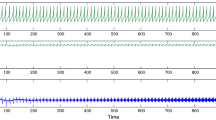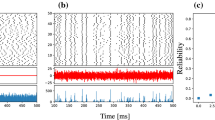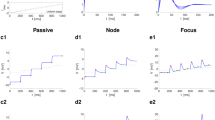Abstract
The reliability of single neurons on realistic stimuli has been experimentally confirmed in a wide variety of animal preparations. We present a theoretical study of the reliability phenomenon in the FitzHugh-Nagumo model on white Gaussian stimulation. The analysis of the model's dynamics is performed in three regimes—the excitable, bistable, and oscillatory ones. We use tools from the random dynamical systems theory, such as the pullbacks and the estimation of the Lyapunov exponents and rotation number. The results show that for most stimulus intensities, trajectories converge to a single stochastic equilibrium point, and the leading Lyapunov exponent is negative. Consequently, in these regimes the discharge times are reliable in the sense that repeated presentation of the same aperiodic input segment evokes similar firing times after some transient time. Surprisingly, for a certain range of stimulus intensities, unreliable firing is observed due to the onset of stochastic chaos, as indicated by the estimated positive leading Lyapunov exponents. For this range of stimulus intensities, stochastic chaos occurs in the bistable regime and also expands in adjacent parts of the excitable and oscillating regimes. The obtained results are valuable in the explanation of experimental observations concerning the reliability of neurons stimulated with broad-band Gaussian inputs. They reveal two distinct neuronal response types. In the regime where the first Lyapunov has negative values, such inputs eventually lead neurons to reliable firing, and this suggests that any observed variance of firing times in reliability experiments is mainly due to internal noise. In the regime with positive Lyapunov exponents, the source of unreliable firing is stochastic chaos, a novel phenomenon in the reliability literature, whose origin and function need further investigation.
Similar content being viewed by others
References
Alexander JC, Doedel EJ, Other HG (1990) On the resonance structure in a forced excitable system. SIAM J. Appl. Math. 50: 1373–1418.
Ali F, Menzinger M (1999) On the local stability of limit cycles. Chaos 9: 348–356.
Arnold L (1998) Random Dynamical Systems. Springer-Verlag, Berlin.
Bair W, Koch C (1996) Temporal precision of spike trains in extrastriate cortex of the behaving macaque monkey. Neural Comput. 8: 1185–1202.
Barnes B, Grimshaw R (1997a) Analytical and numerical studies of the Bonhoeffer van der Pol system. J. Aust. Math. Soci. B 38: 427–453.
Barnes B, Grimshaw R (1997b) Numerical studies of the periodically forced Bonhoeffer van der Pol system. Intl. J. Bifurcation and Chaos 7: 2653–2689.
Berry MJ, Warland DK, Meister M (1997) The structure and precision of retinal spike trains. Proc. Natl. Acad. Sciences USA. 94: 5411–5416.
Bialek W, Rieke F, De Ruyter van Steveninck RR, Warland D (1991) Reading a neural code. Science 252: 1854–1857.
Braaksma B, Grasman J (1993) Critical dynamics of the Bonhoeffer van der Pol equation and its chaotic response to periodic stimulation. Physica D 68: 265–280.
Braun HA, Huber MT, Voigt K, Pakdaman K, Neiman A, Moss F (2001) Tonic-to-bursting bifurcations in neuronal recordings and HH-type computer simulations. American Physical Society Meeting, V23.002 Session V23, Bifurcations in Biological Systems: Neurons, Perception, and Behavior. FOCUS session, March 15, Washington State Convention Center, Seattle, Washington.
Bryant H, Segundo JP (1976) Spike initiation by transmembrane current: A white noise analysis. J. Physiol. 260: 279–314.
Cecchi GA, Sigman M, Alonso JM, Martinez L, Chialvo DR, Magnasco MO (2000) Noise in neurons is message dependent. Proc. Natl. Acad. Sciences USA 97: 5557–5561.
Crauel H (1990) Extremal exponents of random dynamical systems do not vanish. J. Dynamics and Diff. Equs. 2: 245–291.
Dan Y, Alonso JM, Usrey WM, Reid RC (1998) Coding of visual information by precisely correlated spikes in the lateral geniculate nucleus. Nature Neurosci. 1: 501–507.
FitzHugh R (1961) Impulses and physiological states in theoretical models of nerve membrane. Biophys. J. 1: 445–466.
Guttman R, Feldman L, Lecar H (1974) Squid axon membrane response to white noise stimulation. Biophys. J. 14: 941–955.
Haag J, Borst A (1997) Encoding of visual motion information and reliability in spiking and graded potential neurons. J. Neurosci. 17: 4809–4819.
Hunter JD, Milton JG, Thomas PJ, Cowan JD (1998) Resonance effect for neural spike time reliability. J. Neurophysiol. 80: 1427–1438.
Jensen RV (1998) Synchronization of randomly driven nonlinear oscillators. Phys. Rev. E 58: R6907–R6910.
Juusola M, French AS (1997) The efficiency of sensory information coding by mechanoreceptor neurons. Neuron 18: 959–968.
Keller H, Ochs G (1999) Numerical Approximation of Random Attractors in Stochastic Dynamics. Crauel H, Gundlach M, eds. Springer-Verlag, New York. pp. 93–115.
Koch C (1999) Biophysics of Computation. Oxford University Press, New York.
Kröller J, Grüsser OJ, Weiss LR (1988) Observations on phaselocking within the response of primary muscle spindle afferents to pseudo-random stretch. Biol. Cyber. 59: 49–54.
Le Jan Y (1987) Equilibre statistisque pour les produits de difféomorphismes aléatoires indépendants. Annales de l'Institut Henri Poincaré, Probabilités et Statistiques 23: 111–120.
Lestienne R (2001) Spike timing, synchronization and information processing on the sensory side of the central nervous system. Prog. Neurobiol. 65: 545–591.
Longtin A (2000) Effect of noise on the tuning properties of excitable systems. Chaos, Solitions, and Fractals 11: 1835–1848.
Mainen ZF, Sejnowski TJ (1995) Reliability of spike timing in neocortical neurons. Science 268: 1503–1506.
Nagumo JS, Arimato S, Yoshizawa S (1962) An active pulse transmission line simulating a nerve axon. Proc. IRE 50: 2061–2070.
Pakdaman K (2002) The reliability of the stochastic active rotator. Neural Comput. 14: 781–792.
Pakdaman K, Mestivier D (2001) External noise synchronizes forced oscillators. Phys. Rev. E 64: 030901 (R).
Pakdaman K, Tanabe S (2001) Random dynamics of the Hodgkin-Huxley neuron model. Phys. Rev. E 64: 050902 (R).
Pakdaman K, Tanabe S, Shimokawa T (2001) Coherence resonance and discharge time reliability in neurons and neuronal models. Neural Networks 14: 895–905.
Pikovsky A, Zaks M, Rosenblum M, Osipov G, Kurths J (1997) Phase synchronization of chaotic oscillations in terms of periodic orbits. Chaos 7: 680–687.
Reinagel P, Reid RC (2000) Temporal coding of visual information in the Thalamus. J. Neurosci. 20: 5392–5400.
Rieke F, Warland D, De Ruyter van Steveninck RR, Bialek W (1997) Spikes. MIT Press, Cambridge, MA.
Rinzel J, Ermentrout B (1998) Analysis of neural excitability and oscillations. In: Koch C, Segev I, eds., Methods in Neuronal Modeling. MIT Press, Cambridge, MA. pp. 251–291.
Ruelle D (1987) Chaotic Evolution and Strange Attractors. Cambridge University Press, Cambridge.
Schenk-Hoppé KR (1996) Bifurcation scenarios of the noisy Duffing-van der Pol oscillator. Non-linear Dynamics 11: 255–274.
Schneidman E, Freedman B, Segev I (1998) Ion channel stochasticity may be critical in determining the reliability and precision of spike timing. Neural Comput. 10: 1679–1703.
Segundo JP, Stiber M, Altshuler E, Vibert JF (1994) Transients in the inhibitory driving of neurons and their postsynaptic consequences. Neuroscience 62: 459–480.
Segundo JP, Vibert JF, Stiber M, Hanneton S (1995). Periodically modulated inhibition and its postsynaptic consequences. I. General features. Influence of modulatory frequency. Neuroscience 62: 459–480.
Singer W (1999) Neuronal synchrony: A versatile code for the definition of relations? Neuron 24: 49–65, 111-125.
Stiber M, Pakdaman K, Vibert J-F, Boussard E, Segundo JP, Nomura T, Sato S, Doi S (1997) Complex response of living neurons to pacemaker inhibition: A comparison of dynamical models. BioSystems 40: 177–188.
Talay D (1999) The Lyapunov exponent of the Euler scheme for stochastic differential equations. In: Crauel H, Gundlach M, eds., Stochastic Dynamic. Springer-Verlag, New York. pp. 241–258.
Tanabe S, Pakdaman K (2001) Noise-enhanced neuronal reliability. Phys. Rev. E 64: 041904.
Usrey WM, Reid RC (1999) Synchronous activity in the visual system. Ann. Rev. Physiol. 61: 435–456.
White JA, Rubinstein JT, Kay AR (2000) Channel noise in neurons. Trends in Neurosci. 23: 131–137.
Yamanobe T, Pakdaman K (2002) Response of a pacemaker neuron model to stochastic pulse trains. Biol. Cyber. 86: 155–166.
Yamanobe T, Pakdaman K, Nomura T, Sato S (1998) Analysis of the response of a pacemaker neuron model to transient inputs. Biosystems 48: 287–295.
Yoshino K, Nomura T, Pakdaman K, Sato S (1999) Synthetic analysis of periodically stimulated excitable and oscillatory membrane models. Phys. Rev. E 59: 956–969.
Author information
Authors and Affiliations
Rights and permissions
About this article
Cite this article
Kosmidis, E.K., Pakdaman, K. An Analysis of the Reliability Phenomenon in the FitzHugh-Nagumo Model. J Comput Neurosci 14, 5–22 (2003). https://doi.org/10.1023/A:1021100816798
Issue Date:
DOI: https://doi.org/10.1023/A:1021100816798




